Having seen every single Star Trek movie multiple times, I feel like I’m qualified to wander onto the Internet and tell everyone which of these movies suck and which ones don’t. Just to be clear: this isn’t just my opinion, these rankings are fact. Don’t feel free to disagree, because then you’d be wrong and stupid.
Off we go!
13. Star Trek: Into Darkness
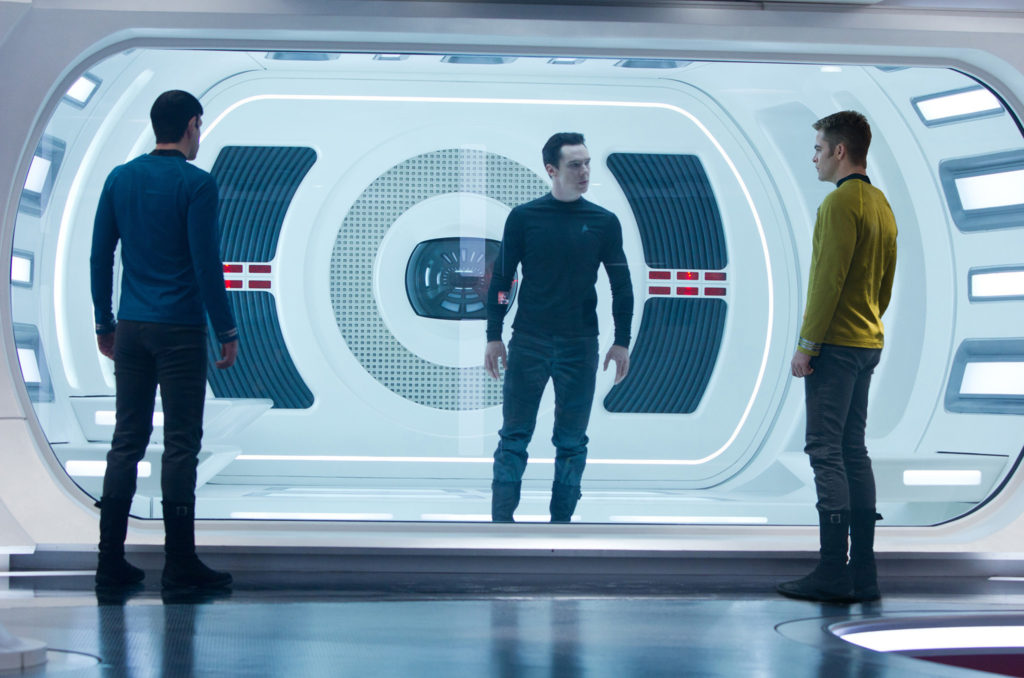
This is the only entry I refuse to preface with “This is not a bad movie”. This is a bad movie.
Star Trek: Into Darkness tries too hard to capture the magic of Star Trek II: The Wrath Of Khan. In doing so fails both the hardcore and casual Star Trek fans so completely, I wonder how exactly this movie came into existence.
For what it’s worth, the first half hour or so (and a few bits beyond) of this film captures the camaraderie between the crew and the idea of exploring (and potentially saving) Strange New Worlds. We see fascinating interactions between Kirk, who bends a few rules, and Spock, who doesn’t understand why telling the truth on an official report is a bad thing. We are caught in a lover’s spat between Spock and Uhura. Later on we see Klingons unmasked, and honestly, they look really badass in this film. These moments are nicely handled.
But then this movie breaks out a big old sledgehammer with the words “WRATH OF KHAN” imprinted on it, and proceeds to beat you across the skull with it, and the results are as dumb as any Trek fan would expect.
The biggest question: why make Khan the villain in this movie, and even more so, why not introduce the crew of the Botany Bay a la Space Seed? We have a great film with Khan as the villain. This never had a chance of measuring up. Why, for example, could Gary Mitchell not have been the villain?
The follow-up question: Why the lame attempt at “we need to start a war with the Klingons” that we saw handled much better in Star Trek VI?
The follow-follow-up question for Khan: why are we casting a British actor in a role envisioned as an Asian dictator played originally by a Spaniard? I won’t fault Benedict Cumberbatch, since he delivers the goods through solid acting, but c’mon. The character is named Khan Noonien Singh. If you can’t find a person of color to portray this character, then you suck at not sucking.
Then there are the decisions that are just plain weird.
Why cast Alice Eve as Dr. Carol Marcus? Why does Carol Marcus have a British accent when her “father” in the movie, Admiral Alexander Marcus, talks like RoboCop? Why does the Admiral have to be Carol’s father? If you’re not going to have Carol Marcus eventually bear Kirk’s son David, why even have her in the movie in the first place? It reads like one dumb decision after another.
And don’t get me started on the idea that Khan’s blood and tribbles are the key to immortality. Trek is notorious for introducing magical fixes that would otherwise change the nature of the galaxy, but of course, we’ve pretty much forgotten about this even before the credits roll.
The whole movie seems like a lame attempt to build up to Kirk fixing the Enterprise, then Spock watches him die so he can shout “KHAAAAANNN!”
God, I hate this stupid, stupid movie.
12. Star Trek: Nemesis
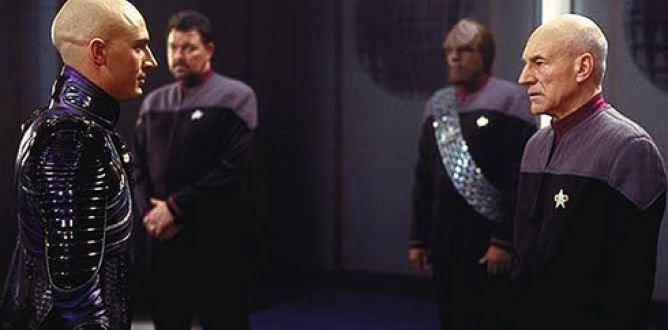
I hate having to put this movie so near the bottom, but there really isn’t any other place for it.
There is an abundance of wonderful character moments in this film. I absolutely love the wedding reception for Troi and Riker. I adored Guinan’s brief appearance. The “Were we Picards always explorers?” dialogue between Shinzon and Jean-Luc was fascinating. The space battles were pulled off fairly well. Jean-Luc ordering the Enterprise to ram into the Scimitar was genuinely spectacular. I appreciated the scene where Commander Data sacrificed his being, and you can bet I shed a few tears at his wake.
And of course, there’s the wonderful score by Jerry Goldsmith.
But there’s just too much to dislike. For example: having another Dr. Soong creation sprung upon the Enterprise this late in the game. Having B4 be part of an elaborate ruse to something something blah blah blah. Introducing a companion race to the Romulan empire that we’ve never heard of until now. Introducing pointless chase scenes into the movie. Seriously, why are Tusken Raiders chasing Picard after he’s recovered B4? Is this supposed to be entertaining? I am not entertained.
And most unforgivably, the scene where Deanna Troi is mentally raped during her honeymoon. What the actual hell was that doing in this movie?
Worf and Crusher and Geordie were sent to the back burners, another travesty.
The writing for this movie was a complete mess. Shinzon was potentially a really interesting character. Maybe if the writers had jettisoned the Remans altogether and given Shinzon a path to command as a Picard clone, this might have been an interesting send-off for the Next Generation crew.
Alas, this movie will be forever remembered as the dying breath of the Berman era. And maybe it was time.
11. Star Trek: The Motion Picture
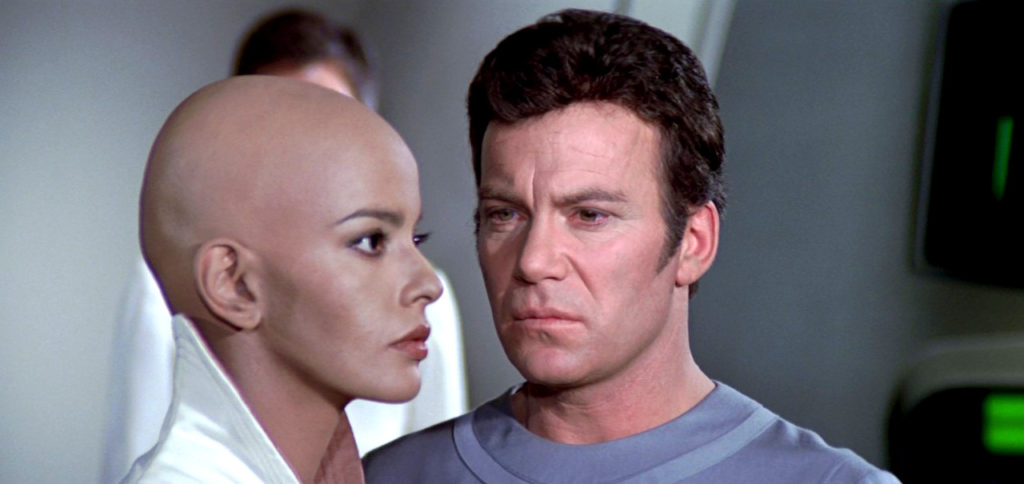
Obligatory “This is not a bad movie”. I re-watched this not long ago, and the concepts and the visual effects are all pretty solid.
But man oh man, is Star Trek: The Motion Picture ever a slog. To its credit, it manages to be a solid film in an era where TV to film translations were in their infancy.
Don’t get me wrong, I love a trippy visual feast like 2001: A Space Odyssey, and that’s clearly the vibe that director Robert Wise was going for. Long, lingering shots of V’Ger and shots of lights dancing across the surface of the vessel and a slow, simmering voyage into the depths of this mighty entity which grew out of the simple craft that was Voyager Six.
And then Spock gets in his jet suit and travels through the depths of V’Ger and we’re treated to even more long, lingering shots of V’Ger and shots of lights dancing across the surface of the vessel and a slow, simmering voyage into the depths of this mighty entity which grew out of the simple craft that was Voyager Six.
And then the Enterprise travels even further into V’Ger and I’ll spare you the description of what happens next. But there are long, lingering shots.
The magical glue that binds it all together is the masterful score of Jerry Goldsmith, which defined not only the original Trek movies but that of Star Trek: The Next Generation as well.
Star Trek: The Motion Picture might have been more successful critically if it had taken even a few moments to focus more on its characters. What did Chekov learn on this voyage? What about Uhura? How about Sulu? Did any of these characters learn anything but to stare in wonder at the forward viewscreen?
Though it must be noted that Spock rejected the Kolinahr because of the allure of V’Ger, and so the impact of the Motion Picture cannot be fully dismissed.
10. Star Trek V: The Final Frontier
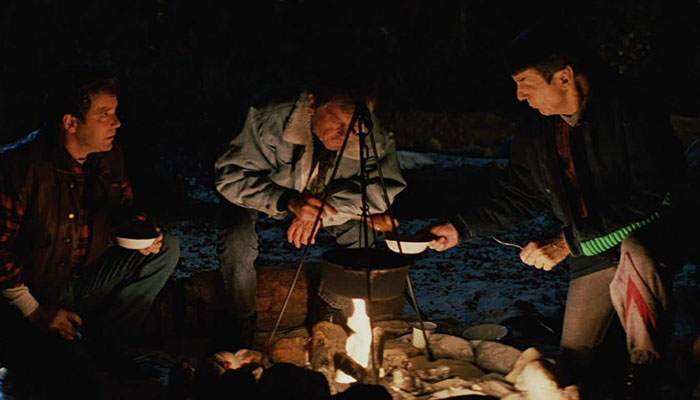
There’s actually a decent movie buried at the core of Star Trek V: The Final Frontier. We get to see spot-on character moments, exciting action scenes, and an absolutely gorgeous score by Jerry Goldsmith. Glimpses of original Star Trek characters being who they ought to be.
Alas, it’s all handled like an ape juggling a pile of plates.
And while it’s not fair to blame William Shatner for everything that went wrong with The Final Frontier, it’s clear that his ego didn’t exactly help with the storytelling. At the outset, his heroic Captain Kirk is shown free-climbing El Capitan, while Chekov and Sulu end up lost in the woods somehow. Good grief, Shat, there’s no need to remind everyone you’ve got top billing in this franchise. Let some of the other characters do stuff other than act as comic relief.
The opening scene of The Final Frontier shows how Sybok uses his powers of persuasion to build his cult. We’re off to a good start here. A wonderful performance from Laurence Luckenbill and excellent parallels to happenings on modern-day earth give the feeling this will be an interesting and provocative Star Trek film.
And then we fade to the title sequence.
And the the title words Star Trek V: The Final Frontier wobble into the frame. They freaking wobble.
How does a special effects house screw up a title sequence on a major motion picture like this? Well, if you’re Bran Ferren, you can also make starships wobble through space and make a big-budget film look like a home video shot by third graders. I understand ILM was busy with other movies at the time, but the end result on this movie was a travesty. The Enterprise-A is inexplicably (I would say unnecessarily) hobbled at the outset by poor construction. Scotty thinks it was put together by monkeys, but I say it was put together by Bran Ferren.
So as the story goes forward, Kirk is of course the center of it all. The ship is a mess but Admiral Whatsisname is sending the Enterprise because “I need Jim Kirk”. Sybok captures the Enterprise and during an interesting attempt to reveal the “secret pain” of the Kirk/Spock/McCoy troika, Kirk doesn’t submit to Sybok’s brainwashing, of course. “I don’t want my pain taken away. I need my pain!” And by the end of the film, wouldn’t you know it, Kirk is asking the important question of “What does God need with a starship?” before before being beamed away in a moment of brutal anticlimax.
So many questionable decisions. Why make Sybok a Vulcan? Let alone, half-brother of Spock? Why? Why make the Enterprise-A such a disaster? Why did the Federation, the Romulans, and the Klingons would build a “Planet of Galactic Peace(TM)” on a backwater dustball where the settlers were guaranteed to squabble? What the heck were the Klingon antagonists doing in this movie? (Could it be Shatner wanted Kirk to have a fistfight with Klaa, but they ran out of time and/or budget to film it? It’s as good a guess as any given the colossal letdown that was the climax of Star Trek V.)
Star Trek V has no lasting implications for the series, makes no attempt to philosophize about the Almighty apart from “maybe he’s here in the human heart”, makes no effort to make any kind of statement apart from: “Hey look at me everyone! I’m William Shatner!” Definitely a movie you can skip.
9. Star Trek: Beyond
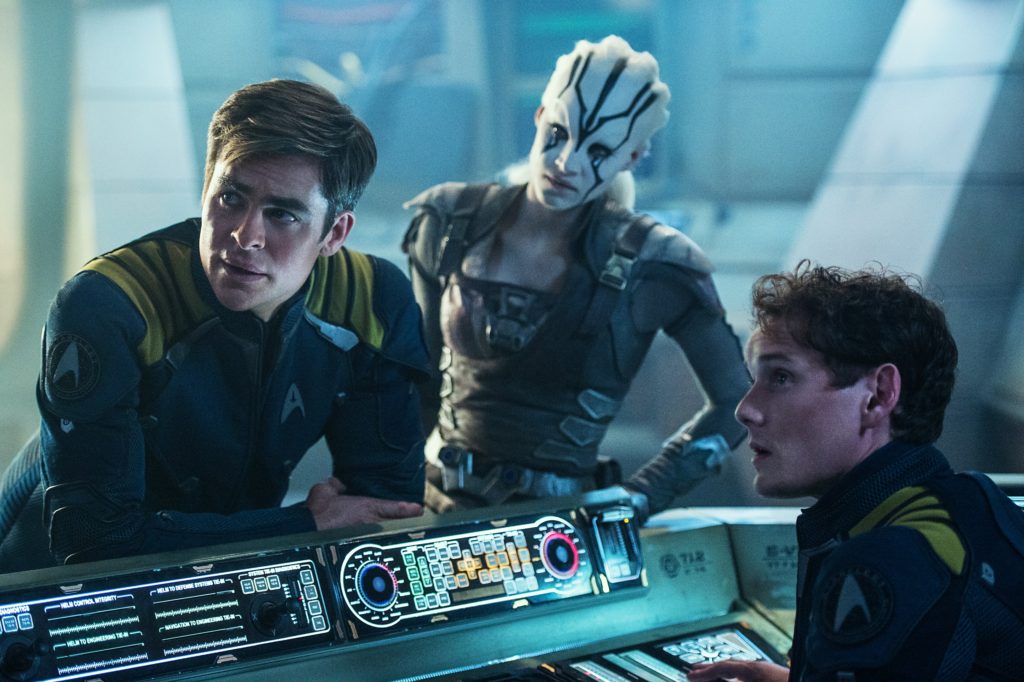
Star Trek: Beyond, like its execrable predecessor, starts strongly before devolving into a yet another mostly pointless series of Kelvin-era action sequences. At least this time, they had the good sense to hand over some of the writing duties to Simon Pegg, who plays Chief Engineer Montgomery Scott but also seems to understand the heart of Star Trek and its fans.
At the outset, Kirk is narrating his Captain’s Log, reflecting on the tedium of the five year mission and how life on the Enterprise has become somewhat mundane for the crew. The only excitement happening is McCoy, for whatever reason, decides to break into Chekov’s locker and steal a beautiful bottle of Scotch with the pretense that it’s Kirk’s birthday. (The two raise a toast on screen that is actually a touching tribute to the loss of Chekov actor Anton Yelchin.)
Then along comes a the bad guy, and the Enterprise is boarded and dismembered bit by bit, and the crew is forced to abandon ship in a thrilling (and I must admit, heartbreaking) sequence. From that on, it’s a pretty boilerplate story that has the lead “alien” somehow being Idris Elba as a former Starfleet officer and there are motorcycle chases and fistfights and… honestly I haven’t watched this movie more than a couple of times. I remember enjoying the movie overall, but I also remember I didn’t buy the villain’s motives, and I wished the movie could have finished as strongly as it started.
But I also felt like the people in charge of the Trek film franchise did their best to make up for the awful steaming pile that was Into Darkness, and for that, I’m grateful. And it gave us a look the U.S.S. Enterprise NCC-1701-A. Not bad.
8. Star Trek: Generations

I was more hyped for the release of Star Trek: Generations than I was for any other Trek movie, ever. I had fallen deeply in love with Star Trek: The Next Generation, and the implications of a collaboration between Kirk and Picard had me feeling all tingly. The crossover event of all time!
Alas, the movie couldn’t cross over its own expectations.
I don’t know what was worse about Generations: that it killed Captain James T. Kirk not once, but twice, and both times he died in the lamest way possible: the first time by swapping out some technobabble in the engineering bay, and the second time, reaching for the remote. Why even kill Kirk in the first place?
It’s also a crime that Kirk never got to set foot on the Enterprise-D and that the two captains had so little real screen time together.
Roddy McDowell gave a fine performance as a villain, and had some wonderful lines, and I understood Soran’s desire to return to the Nexus at the cost of an entire planet. But the effectiveness of Soran is compromised at every turn lazy and awful writing (“no other way” to get into the Nexus? please), bad science (a missile fired into a star dims it right away, when it should have been several minutes for the light to reach the planet), and an inexplicable team-up with long-time Klingon sisters Lursa and B’etor.
And the movie suffers from just weird and dumb stuff that somehow made it to screen. Like, Riker orders Worf to fire a “spread” of photon torpedoes at the bird of prey attacking them. At the critical moment, Worf fires a single torpedo that somehow magically goes back in time to destroy General Chang’s bird of prey from Star Trek VI. It’s hard to know what anyone was thinking on this production.
At its best, though, Generations has some wonderful character moments for the crew of the Enterprise-D. Picard’s devastating off-camera loss of his brother Robert gave Sir Patrick Stewart a chance to shine and bring even more depth to the character. And it gets even better later in the film, as Picard lives his ideal life with his fictional Nexus family. Data receiving his emotion chip was another highlight; I’ve always argued exploring his humanity could have been the focus of a whole separate movie.
This movie needed to feel bigger than it was, but unfortunately it just has too many things going on, and not enough time to give it much heft in the greater Star Trek universe. At least it gave us a spectacular crash of the saucer section, and an excuse for the franchise to bring us the Enterprise-E.
7. Star Trek: Insurrection
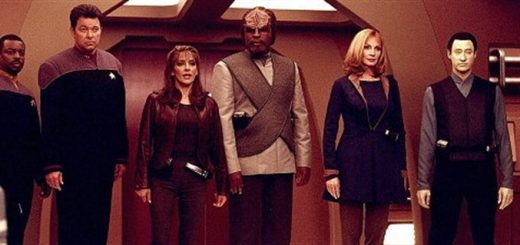
Star Trek: Insurrection is a fine little movie, with a decent story and interesting character development, deft direction from Jonathan Frakes, decent cinematography, and solid performances. And also a pretty good space battle thrown in for good measure. Oh and lest I forget, the always sensational score by Jerry Goldsmith.
There really isn’t anything wrong with this film, apart from that it doesn’t really justify its existence as a movie instead of a two-parter in a season of The Next Generation. One by one we’re introduced to elements that we’ve never heard of and have little reason to care: A remote planet. A new civilization. A generic admiral. A generic villain. A love interest for Picard. And once the movie is over, we’ll never see them again. We don’t get to learn whether Picard spends some shore leave with Anij, nor does there appear to be any fallout for Jean-Luc’s refusal to obey orders from Starfleet. You could skip this movie without feeling you’ve missed much.
The one lasting thing that Insurrection did deliver was a delight to behold: the rekindling of the sparks between Riker and Troi. I was surprised that not only did they stay together, but even got themselves hitched in the next movie! The “reset button” that Trek usually hits at the end of every episode is mercifully skipped. Riker and Troi have their happy ending (one that even lasts into the Picard TV series). So this was nice.
Even if Insurrection left me wanting a little more there there, at least it was an entertaining little diversion.
6. Star Trek
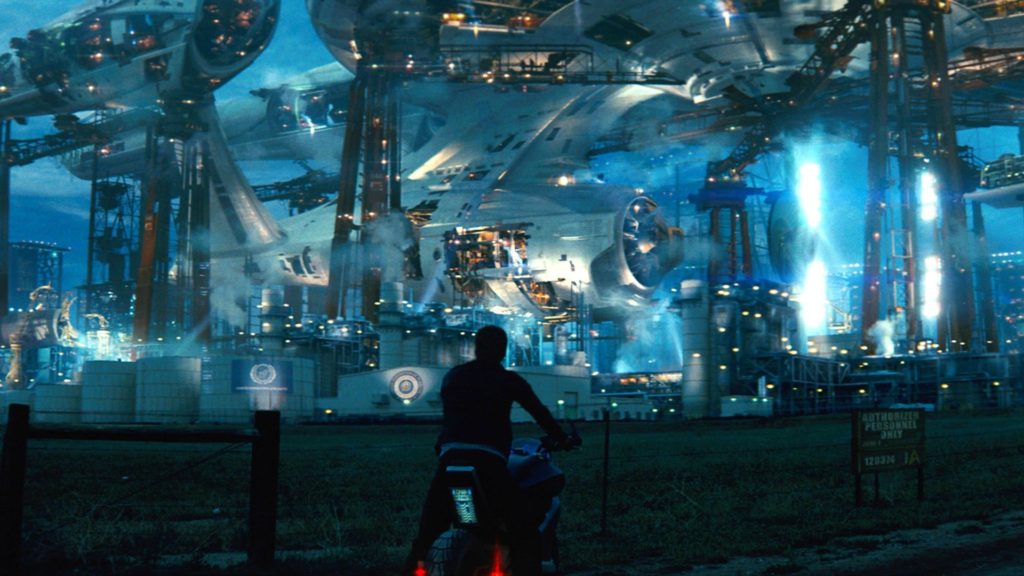
2009’s re-launch of the Star Trek franchise was an unusual beast: simultaneously a sequel, a prequel, and a reboot, it figured out a way to get a soft reset and define the Trek universe on its own terms: the Kelvin Timeline. The concept worked brilliantly; those who were familiar with Kirk, Spock, and McCoy could be reintroduced to these characters, while newcomers could be brought up to speed with who they were when they were young.
The movie didn’t shy away from Easter eggs for Trek geeks: A green Orion female! Sulu fencing! Christopher Pike in a wheelchair! We even got to see the Kobiyashi Maru simulation for the first time on screen. But best of all, the movie found a way to give us Leonard Nimoy as Spock. Spock was the cement that held together the old timeline and the new, and lent serious cred to this new series.
The cast obviously knows they’re stepping into some pretty big shoes, and for the most part it’s fine. Neither Sulu nor Uhura nor Scotty bear much resemblance to their old selves, and I’m still trying to figure out why Anton Yelchin, who looks nothing like Walter Koenig, was cast as Chekov.
The script for the film is the kind of big dumb thing you’d expect from its director. It’s a shame that J.J. Abrams didn’t think movie audiences were clever enough to enjoy Star Trek without lots of shakey-cam, lots of explosions, lots of fights and shoot-outs, and barrages of lens flares. Star Trek also contains way too much bad science, too many plot holes, and too many leaps of logic. It’s better not to think of this movie as a Star Trek film, but as a movie that has Star Trek characters in it.
And that’s the thing that makes the movie work: the characters. Watching Uhura spar with Kirk feels right. Watching Bones and Kirk bond for the first time feels right. I couldn’t even find any way to be outraged about the relationship between Uhura and Spock. It worked. It just felt right. Even if these characters are vastly different from the way they were portrayed originally, you get the sense they’re being treated with respect for the series that came before.
The sweeping score by Michael Giacchino may not be as iconic as Jerry Goldsmith’s, but it’s still grand and fitting. And when the credits roll and we’re treated to the original TV theme, it was a perfect endcap to a movie that knew better than to try to anger its fan base.
5. Star Trek III: The Search For Spock
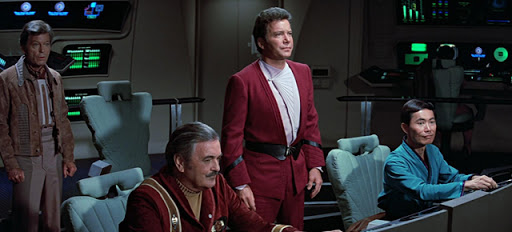
Now we’re getting to the really good stuff.
I recently re-watched Star Trek III in my fancy new VR headset, and I was surprised to find how much I enjoyed it and how well-made it really is. To me it hits just the right balance between humor, drama, tragedy, and hope. The camera is allowed to linger and marvel. We the viewer can enjoy a leisurely journey, instead of being barraged by events. This is how I like my movies. Not all shakey-cam.
“The death of Spock is like an open wound,” Kirk laments in his Captain’s Log, and I know just how he feels, having been a 12 year old kid sobbing on his living room floor for almost an entire day. Right away, we understand what motivates Kirk to break every rule Starfleet has in order to steal his crippled ship and find his old friend.
This film doesn’t shy away from gut punches. We witness both the brutal murder of Kirk’s son David, and the gradual destruction of our favorite starship. Rest in peace, Enterprise. Watching your hull implode felt like one of the most depressing events I’ve ever witnessed.
The Search For Spock also gives us a number of nice character moments for almost everyone. Uhura has a nice bit with “Mr. Adventure”, we have Sulu’s “Don’t call me tiny” and Bones muttering “That green-blooded sonuvabitch” and the best parting line of all from Kirk: “I kick have HAD kick enough of YOU!” *BOOT*
The visual and effects in this movie are striking, with the approach of Enterprise to space dock being maybe my favorite out of any Star Trek film of all. The movie is made all the more beautiful by James Horner’s score, with its soaring strings and themes that started in Star Trek II and continued here.
Only a couple of gripes. Chekov mostly sits around in this film and doesn’t contribute a whole lot. Also, I wish that there hadn’t been whatever weird salary snag that saw Kirstie Alley replaced as Saavik. I know many fans prefer Robin Curtis to Alley, but I’m just not one of them. Didn’t help that I had a huge crush on Saavik at the time, either.
In any event, the events of Star Trek III served as a springboard for the highly entertaining Voyage Home that would follow.
4. Star Trek VI: The Undiscovered Country
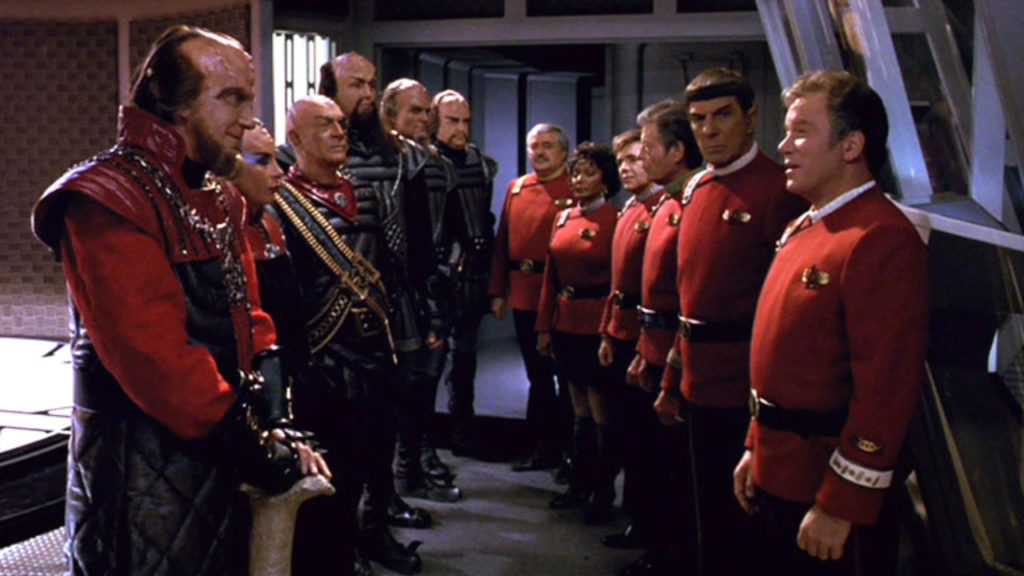
Nicholas Meyer’s triumphant return to the director’s chair resulted in a movie that, while uneven in spots, allowed fans a sigh of relief after the rather tepid fan reception of Star Trek V.
And it’s near perfect in every way: good-looking sets, delightful visual effects courtesy of ILM, wonderful performances, a rousing space battle, and an intriguing whodunnit. Highlights include Hikaru Sulu, Captain of the U.S.S. Excelsior (finally!), a glorious Kirk vs. Kirk fist fight, an enormously entertaining Christopher Plummer as General Chang, Colonel Worf acting as counsel to Kirk and McCoy, and a dying Ghorkon pleading with Kirk “Don’t let it end this way”.
On the soundtrack front, Cliff Eidelman steps in to provide the score, and while I don’t believe it’s as nice as the compositions from Jerry Goldsmith or James Horner, it has a certain haunting, urgent quality that goes well with a story that heavily involves Klingons.
Only real nits: Star Trek VI certainly threw Admiral Cartwright to the wolves, after making him a familiar face from Star Trek IV: The Voyage Home. I think it would have been a far, far braver decision to also have Saavik been the traitor to peace instead of Kim Cattrall’s Valeris, a character we’d only been introduced to at the beginning of the film. But the producers were apparently afraid that fans wouldn’t accept Saavik as a traitor.
Also, Klingon blood was established as red in the Next Generation TV series, not the bismuth looking blobs.
Finally, there’s some dodgy editing happening with the state dinner scene and also the trial. The dialogue ended up disjointed and clunky in these scenes. I’d be curious to know what got left on the cutting room floor.
As the final voyage of the original crew, Star Trek VI gave everyone the best, most appropriate send-off I could have ever wished for.
3. Star Trek IV: The Voyage Home
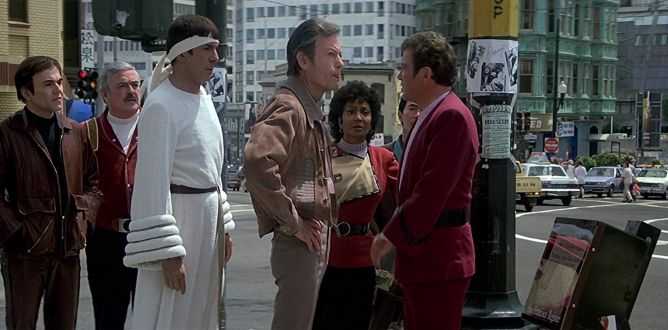
This movie has no business being as well-received as it was. It’s a Star Trek film with a light, bouncy soundtrack by Leonard Rosenman; characters who use swear words; madcap chases; no actual villain in the story; and maybe most damningly, no U.S.S. Enterprise (until the very end, that is). Critically it received near-universal accolades. Financially it was far and away the best-received Trek film of the time, appealing to fans and non-fans equally.
More commonly known as “the one with the whales”, Star Trek IV: The Voyage Home is a funny, warm tale about a group of fish out of water, doing their best to navigate the 20th century while on a mission to save the planet’s future. There’s very little nuance to the story or the plot; the audience and the crew make their way from one situation to another, trying to find 20th century solutions to 23rd century problems and vice-versa. And it’s even more glorious than it sounds.
Directed by Leonard Nimoy and co-written with Nicholas Meyer, there’s not a single main character who isn’t given the spotlight at some point. Kirk tells a cabbie “well, double dumb-ass on you!” and gets a romantic interest (because duh). Spock mind-melds with Gracie and gets to tell Kirk “One damn minute, Admiral”. McCoy gets to practice his style of medicine and discuss philosophy with his newly resurrected crewmate. Sulu gets to fly an antique Huey. Uhura translates whalespeak. And best of all, Chekov pricelessly bumbles his way through an interrogation by U.S. military intelligence officials. The characters in this movie matter, their friendships are the key to the success of the mission, and as a result, we all care about the outcome.
My only complaint, which seems so lame as I make it, is that the bridge of the captured Klingon vessel (renamed the USS Bounty) in no way resembles the bridge seen in the previous movie, Star Trek III. I’m pretty sure a Bird of Prey is too small a vessel for a secondary bridge, nor would the crew have access to Klingon technology to “refit” the original. I like continuity, and it kind of bugs me that they didn’t even seem to try.
Also, I really would have liked to know where Gillian Taylor ended up. Did she see Kirk around the galaxy? Did she team up with Dr. Carol Marcus to try to use Genesis technology to repopulate humpback whales?
At the end of the movie, the crew is escorted through space dock to their new assigned vessel, we find out it’s a Constitution class vessel with the registry NCC-1701-A, and everyone’s home again. As it sails off majestically from port, Kirk says “let’s see what she’s got” as they sail off to warp, and that’s when Shatner goes and takes a giant dump on the franchise with the next film.
But hey. The one with the whales. We can always just re-watch it.
2. Star Trek: First Contact
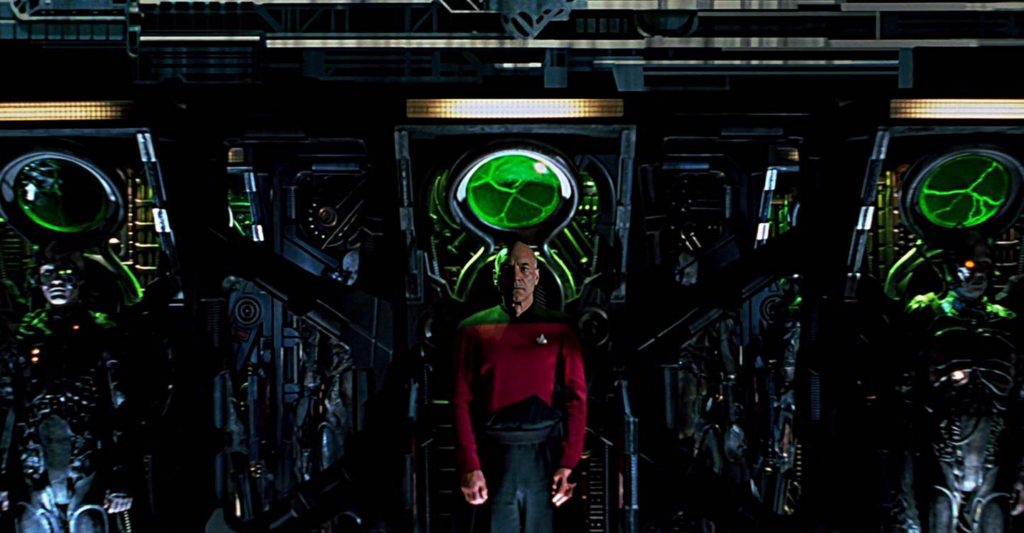
I’m a big fan of the Borg, a big fan of Picard, and a big fan of action-epic films, and you know what, Star Trek: First Contact gave me everything I could have ever hoped for in a Star Trek film.
Jonathan Frakes sat down in the directors’ chair, and he and the script writers knew immediately what to do. They reminded us what a lethal, frightening enemy the Borg were. They added gruesome horror elements. They added moments of levity with the secondary characters. They knew when to add Magic Carpet Ride to the soundtrack. They added amazing camera work, costumes, makeup, and visual effects.
And most importantly the design team came up with the U.S.S. Enterprise-E, the most badass starship ever to bear the NCC-1701 registry.
They also gave us Dixon Hill and the Holodoc and Reginald Barclay. They gave us a version of Zephram Cochrane that nobody expected in a thousand years. They gave Levar Burton his (kinda-sorta) actual eyes back. They gave Data a skin graft and a chance to practice his multiple techniques..
They gave us a gorgeous battle between Starfleet and a Borg cube. They gave us a harrowing space walk. They gave us the introduction of the alluring and deadly Borg queen.
They gave us Lily, Cochrane’s right-hand and the perfect “everyman” from the 21st century, who helps bring Picard back to reality after he breaks his little ship.
First Contact was nothing short of a gift, one that came at the exact moment the franchise needed it.
1. Star Trek II: The Wrath Of Khan
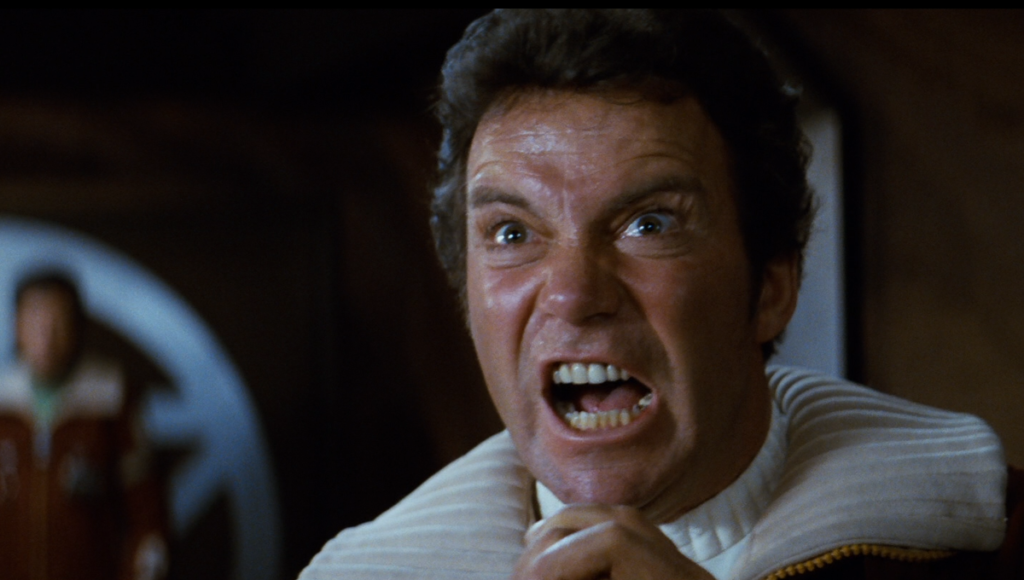
Big surprise, right? Star Trek fan puts Wrath of Khan at the top of the list? Go figure.
I can’t add any meaningful commentary about Wrath of Khan hasn’t already been said, but I will point out that the worst Star Trek movie ever made tried too hard to copy the best Star Trek movie ever made.
Now excuse me while I try to avoid behaving like a 12 year old sobbing on the living room floor.
